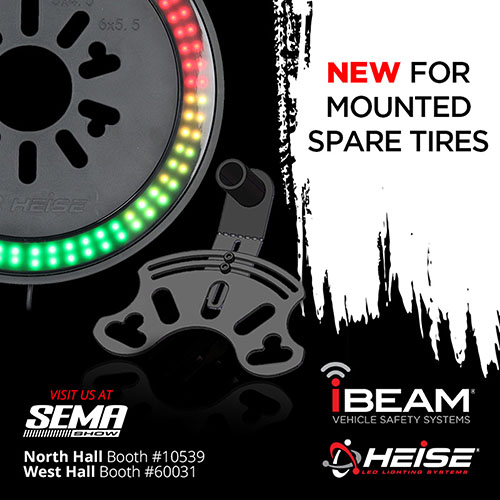Sealed beam headlights are headlamp assemblies that consist of an enclosure with a bulb in front of a glass lens. The entire unit is sealed, meaning that none of the parts can be replaced individually.
Initially designed for road vehicle headlight service, sealed beam headlights have also found applications in other areas. They are distinct from composite headlights, which are made up of multiple pieces that can be disassembled. Sealed beam headlights provide brighter and whiter light compared to incandescent lighting, and they also prevent glare during adverse weather conditions.
While most cars and trucks on the road use sealed beam headlights, modern vehicles have transitioned to other headlight options such as halogen, LED, and HID lights.
Understanding Sealed Beam Headlights
Sealed beam headlights are headlamp assemblies that consist of a glass enclosure with a bulb in front of a lens. Unlike composite headlights, the entire unit is sealed and cannot be disassembled. Originally designed for road vehicle headlamp service, sealed beams have been widely used in automotive lighting.
Definition And Components Of A Sealed Beam Headlight
A sealed beam headlight is a type of headlamp assembly that consists of an enclosure with a bulb in front of a lens, all made of glass. Unlike other types of headlights, such as composite headlights, sealed beam headlights are a single unit, and their parts cannot be replaced separately.
Features And Advantages Of Sealed Beam Headlights
Sealed beam headlights offer several features and advantages that make them a popular choice in the automotive industry:
- Durability: Sealed beam headlights are known for their durability as they are made entirely of glass, making them resistant to scratches and shattering.
- Easy installation: Due to their single-unit design, sealed beam headlights are easy to install as they can simply be plugged into the vehicle’s headlight socket.
- Cost-effective: Sealed beam headlights are often more affordable compared to other types of headlights, making them a budget-friendly option for vehicle owners.
- Consistent lighting: The sealed design of these headlights ensures a consistent beam pattern and light output, providing reliable visibility on the road.
Evolution And History Of Sealed Beam Headlights In The Automotive Industry
Sealed beam headlights have a fascinating history of evolution within the automotive industry:
- Introduction: Sealed beam headlights were originally introduced for road vehicle headlamp service and quickly gained popularity due to their simplicity and effectiveness.
- Technological advancements: Over time, advancements in technology led to the development of different types of headlights, such as composite headlights, which consist of multiple pieces that can be disassembled.
- Modern applications: Although composite headlights have become more prevalent in modern vehicles, sealed beam headlights still have their applications, especially in older vehicles or specific industrial applications.
- Automotive landscape: The advent of sealed beam headlights shaped the automotive landscape, influencing the design and functionality of vehicles.
Understanding sealed beam headlights provides insight into an essential component of vehicle lighting systems. With their durability, cost-effectiveness, and historical significance, sealed beam headlights continue to play a role in the automotive industry, both in practical and nostalgic contexts.
Comparing Sealed Beam Headlights With Composite Headlights
Sealed beam headlights are headlamp assemblies made completely of glass, consisting of an enclosure with a bulb in front of a lens. Unlike composite headlights, sealed beam headlights cannot have their parts replaced separately as they are sealed units. They were originally introduced for road vehicle headlamp service but have since been used in other applications.
H3comparing Sealed Beam Headlights With Composite Headlights/h3When it comes to automotive headlights, there are two main types that have been used over the years – sealed beam headlights and composite headlights. While both serve the same purpose of providing illumination for the road ahead, they differ in their construction and functionality. |
H3overview Of Composite Headlights/h3Composite headlights, as the name suggests, are made up of multiple components that can be disassembled. These components include the bulb, reflector, and lens, which can be replaced individually when needed. This modular design allows for easier maintenance and repairs, as well as the flexibility to upgrade to newer and more advanced lighting technologies like LED or HID. |
H3key Differences Between Sealed Beam Headlights And Composite Headlights/h3The main difference between sealed beam headlights and composite headlights lies in their construction and replaceability. Sealed beam headlights are single, one-piece units consisting of a bulb in front of a glass lens. The entire assembly is sealed and cannot be disassembled or repaired. On the other hand, composite headlights consist of multiple parts that can be replaced individually, allowing for greater flexibility and cost-effective repairs. |
H3pros And Cons Of Sealed Beam And Composite Headlights/h3Sealed beam headlights:
Composite headlights:
|
The Benefits Of Sealed Beam Headlights
Sealed beam headlights are headlamp assemblies made entirely of glass, with the bulb enclosed in front of a lens. Unlike other headlights, sealed beams cannot be replaced separately as the whole unit is sealed. Originally designed for road vehicles, they have since been used in various applications.
Sealed beam headlights are a popular choice among vehicle owners for several reasons. These headlights offer superior brightness and visibility, weather resistance and durability, easy installation and maintenance, as well as cost-effectiveness and longevity.
Superior Brightness And Visibility
One of the major benefits of sealed beam headlights is their superior brightness and visibility. These headlights are designed to provide a powerful beam of light, ensuring that the road ahead is well-illuminated. Whether you are driving in low-light conditions or through inclement weather, sealed beam headlights offer excellent visibility, allowing you to spot potential hazards on the road. The bright and focused light also enhances your own visibility to other drivers, increasing safety on the road.
Weather Resistance And Durability
Sealed beam headlights are constructed with a glass enclosure that provides excellent weather resistance. This means that they are able to withstand various weather conditions, including rain, snow, and extreme temperatures. Unlike other headlights that may be susceptible to water damage or fogging up, sealed beam headlights remain clear and functional in all types of weather. Additionally, the durable glass construction ensures that the headlights are resistant to cracks and damage, increasing their lifespan.
Easy Installation And Maintenance
Installing sealed beam headlights is a straightforward process that can be easily done by vehicle owners. These headlights come as one sealed unit, which means that you simply need to remove the old unit and replace it with a new one. There is no need for complex wiring or additional parts. As for maintenance, sealed beam headlights require minimal upkeep. Since the entire unit is sealed, there are no separate parts that need to be replaced or cleaned. This makes them a hassle-free option for those who want a low-maintenance lighting solution for their vehicles.
Cost-effectiveness And Longevity
Sealed beam headlights are known for their cost-effectiveness and longevity. Compared to other types of headlights, such as composite headlights, sealed beam headlights are often more affordable to purchase. Additionally, their durable construction and weather resistance ensure that they have a longer lifespan, reducing the need for frequent replacements. This not only saves you money in the long run but also minimizes the environmental impact of constantly disposing of old headlights.
The Evolution Of Sealed Beam Headlights
Sealed beam headlights have come a long way since their introduction in road vehicle headlamp service. These headlamp assemblies consist of an enclosure with a bulb in front of a lens, both made entirely of glass. What sets sealed beam headlights apart is their unique construction – the entire unit is sealed, and none of the parts can be replaced separately.
Historical Development Of Sealed Beam Headlights
The historical development of sealed beam headlights showcases the evolution of automotive lighting technology. In the early years, headlights were simple and round, with a single filament and reflector enclosed within a glass lens. These sealed beam units were known for their durability and ease of replacement.
As automotive design evolved, so did the need for improved lighting. The advent of composite headlights, consisting of multiple pieces that can be disassembled, provided new opportunities for advanced lighting technology. However, sealed beam headlights continued to hold their ground as a popular choice in automotive lighting due to their simplicity and reliability.
Technological Advancements In Sealed Beam Lighting
Over time, sealed beam headlights have seen several technological advancements aimed at enhancing their performance. One notable improvement was the introduction of halogen sealed beam headlights. These sealed beam units delivered brighter and whiter light compared to traditional incandescent lighting, allowing for better visibility and reduced glare during adverse weather conditions.
Another significant development in sealed beam lighting was the integration of LED technology. LED sealed beam headlights offer increased energy efficiency and a longer lifespan compared to traditional sealed beam units. With their ability to produce strong, focused beams of light, LED sealed beam headlights have become popular among car enthusiasts and drivers looking for a modern upgrade to their lighting systems.
Impact On Automotive Design And Safety
The widespread use of sealed beam headlights had a significant impact on automotive design and safety. Their standardized design allowed automakers to create vehicles with precise headlight housing dimensions, making it easier to design and produce vehicles with cohesive aesthetics.
Moreover, sealed beam headlights played a crucial role in ensuring driver safety. The hermetically sealed construction of these headlights provided protection against moisture and debris, preventing damage to critical components and enhancing the longevity of the lighting system. This design also helped maintain consistent beam patterns, ensuring optimal visibility for drivers on the road.
Overall, the evolution of sealed beam headlights has been marked by advancements in lighting technology, improvements in performance, and their impact on automotive design and safety. From their humble beginnings as round, simple headlights to the integration of halogen and LED technology, sealed beam headlights continue to be a reliable and popular choice for drivers worldwide.
Modern Innovations In Sealed Beam Headlights
Sealed beam headlights are headlamp assemblies made entirely of glass, with an enclosure, a bulb, and a lens. Unlike composite headlights, sealed beams cannot have their parts replaced separately. These headlights were originally introduced for road vehicle headlamp service but have been used in various other applications as well.
Introduction Of Halogen, Led, And Hid Options
Modern innovations have brought significant advancements to sealed beam headlights, offering drivers a range of options for improved visibility and performance. One such advancement is the introduction of halogen, LED, and HID options. These alternatives to traditional sealed beams have revolutionized the automotive lighting industry, providing brighter and more efficient illumination.
Halogen sealed beam headlights, for instance, incorporate a tungsten filament encased in a halogen gas-filled bulb. This combination produces a brighter and whiter light output compared to standard incandescent bulbs. Halogen bulbs also have a longer lifespan and consume less energy, making them a popular choice among car owners.
LED sealed beam headlights, on the other hand, utilize light-emitting diodes to produce bright, crisp illumination. LEDs are known for their energy efficiency and long lifespan, making them an eco-friendly alternative. Additionally, LED headlights offer a quicker response time, allowing drivers to detect potential hazards on the road sooner.
HID (High-Intensity Discharge) sealed beam headlights offer another advanced option. These headlights use xenon gas to produce a bright white light that closely resembles natural daylight. HID headlights provide exceptional visibility and can improve safety during nighttime driving. They are often preferred by drivers who prioritize performance and aesthetics.
Enhanced Performance And Energy Efficiency
One of the key benefits of modern sealed beam headlights is their enhanced performance and energy efficiency. Halogen, LED, and HID options all provide brighter illumination compared to traditional sealed beams. This improved visibility allows drivers to see farther and clearer, making it easier to identify potential obstacles and hazards on the road.
Moreover, these innovative headlights are more energy-efficient, helping drivers reduce their carbon footprint and save on fuel costs. Halogen sealed beam headlights, for example, consume less energy compared to older incandescent bulbs without compromising on brightness. LED and HID headlights are even more efficient, using minimal energy to produce powerful illumination.
By upgrading to halogen, LED, or HID sealed beam headlights, car owners can enjoy improved visibility, which is crucial for safe and comfortable driving, particularly in low-light conditions such as at night or during inclement weather.
Integration With Advanced Driver Assistance Systems (adas)
In addition to enhanced performance and energy efficiency, modern sealed beam headlights can integrate seamlessly with advanced driver assistance systems (ADAS). ADAS technologies, such as adaptive headlights, automatic high beams, and lane departure warning systems, rely on accurate and precise lighting to function effectively.
Halogen, LED, and HID sealed beam headlights can provide the necessary illumination for these ADAS features to work optimally. For example, adaptive headlights use sensors to detect the direction of the vehicle and adjust the beam pattern accordingly, improving visibility around curves and corners. LED and HID headlights, with their brighter and more focused beams, are particularly well-suited for this purpose.
Furthermore, advanced sealed beam headlights can complement automatic high beam systems by automatically adjusting the brightness and range of the headlights to avoid blinding oncoming drivers. This improves safety without requiring manual adjustment of the high beams.
Overall, the integration of modern sealed beam headlights with ADAS technologies enhances driver safety and convenience, making driving a more enjoyable experience.

Credit: www.metraonline.com
Frequently Asked Questions Of What Are Sealed Beam Headlights
How Do I Know If I Have Sealed Beam Headlights?
If your car or truck has screws holding a trim piece around the headlight and another metal ring holding the headlight itself, then it likely has sealed beam headlights. These headlights have the bulb, reflector, and lens as one unit, and cannot be replaced separately.
Are Sealed Beam Headlights Better?
Sealed beam headlights are headlamp assemblies made of glass that cannot be disassembled or have parts replaced separately. They were originally used for road vehicle headlamp service but have since been used in other applications.
Do Any Cars Still Use Sealed Beam Headlights?
Yes, some cars still use sealed beam headlights. Sealed beam headlights consist of a bulb and lens enclosed in a glass unit that cannot be replaced separately. Although they were originally introduced for road vehicles, they have since been applied in other areas as well.
When Did Cars Stop Using Sealed Beam Headlights?
Cars stopped using sealed beam headlights in the late 1980s.
Conclusion
Sealed beam headlights are a unique type of headlamp assembly that consists of a bulb encased in a glass enclosure. Unlike other headlight types, sealed beams are completely sealed and cannot have their parts replaced separately. Originally designed for road vehicle headlamp service, sealed beam headlights have found applications in various industries.
With their bright and reliable lighting capabilities, sealed beams have been a popular choice for many car enthusiasts. Whether you’re looking for a classic aesthetic or simply want a dependable lighting solution, sealed beam headlights are worth considering. Upgrade your vehicle’s lighting system and enjoy the benefits of these iconic headlamps.



